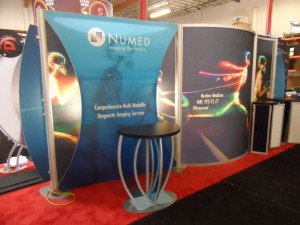Building Trust in your Trade Show Booths
“Money money money, hubba hubba hubba, who can you trust?”. You might or might not remember that quote from Jack Nicholson in the 1989 Batman, but these days it seems to really sum up the whole trade show experience. The more razzmatazz vendors throw into their trade show displays, the harder it can be for visiting buyers to figure out who they can actually trust as partners.
 Beyond the trade show industry, this is becoming a widespread issue for all businesses. Today’s buyers, both consumer and corporate, are increasingly well-informed and accustomed to doing outside research in their buying decisions.
Beyond the trade show industry, this is becoming a widespread issue for all businesses. Today’s buyers, both consumer and corporate, are increasingly well-informed and accustomed to doing outside research in their buying decisions.
A Nielsen survey last year showed that 59% of US buyers, in general, were influenced by self-guided online research. And among active Internet users specifically, a staggering ninety percent now report being influenced by favorable reviews online. And only slightly fewer are influenced by negative reviews.
I haven’t seen any numbers for this year, yet, but I see no reason whatsoever to expect them to do anything but go up.
This means honesty and trustworthiness are goals you should be aiming to achieve in your trade show presentations, even if they’re hard to quantify. Purchasing decisions aren’t made solely based on data, after all. Someone’s “gut feeling” based on meeting a booth staff member could be just as important.
Using Trade Show Appearances To Build Trust
1 – Be honest.
No, honestly. The #1 best way to be trustworthy is never get caught lying, or and being relatively open about any issues that might come up. For example, when you have product features that might get cut, it’s the difference between promising them anyway or mentioning them as potential inclusions.
(Side note: Use this for polling your visitors at the trade show. If you’re on the fence about a feature, use a poll of some sort to decide its inclusion. It turns a potential bad PR move into a pro-customer tactic instead.)
Strict “message control,” in general, is becoming nearly impossible to maintain in an online world where there might be dozens – or thousands – of concurrent conversations about a company. Attempts to sweep issues under the rug simply don’t work, most of the time, or at least become unreasonably risky to PR.
Bad news, or cut features, will almost always come out via the Internet, whether you want it to or not. These days, any “message control” at all largely depends on owning up and being one of the first voices, even if it’s not on a topic you’d like to talk about.
2 – Build yourself up, don’t tear others down.
People don’t like all the negativity in advertising, and while there are certain sorts who seem to prefer a “bully,” that’s not true for the general public at large. If someone comes to your expo booth, they want to hear what makes you good, not what makes your competition bad.
 Increasing distrust of others does not, necessarily, cause people to trust you more. Companies known for “FUD” tactics — sowing Fear, Uncertainty, and Doubt about competitors — tend to pick up a negative reputation for it over the years. This is especially true if they sometimes fail to deliver.
Increasing distrust of others does not, necessarily, cause people to trust you more. Companies known for “FUD” tactics — sowing Fear, Uncertainty, and Doubt about competitors — tend to pick up a negative reputation for it over the years. This is especially true if they sometimes fail to deliver.
(Who, for example, ever pays much attention to Sony’s statements about the relative strength of their products prior to release? They’re infamous for inflated claims.)
Focus on showcasing your own achievements and accomplishments. If you have a product or supply chain innovation that you believe is honestly superior to others, it’s fine to say so – but frame it in terms of what you’ve done.
The proof is in the pudding, as they say.
3 – Have naturalistic interactions.
“Naturalism” is one of those very fuzzy concepts, of the sort that leave acting coaches pulling their hair out trying to explain. Basically, it boils down to how genuine someone seems when they’re talking to someone else.
In terms of exposition interactions, this could mean:
- Don’t over-script or practice pitches until they’re rote. It sounds fake and artificial.
- Asking questions, rather than pitching. ie, Respond to what your visitor says.
- Being positive about the company, without being a mindless cheerleader / yes-man.
- Maintaining awareness of the trade show and your competitors products, with a willingness to discuss their features reasonably.
- Demonstrating a superior knowledge of your own products. Few, if any, visitor questions should go unanswered.
- Honestly targeting product suggestions according to the buyer, not simply pushing the biggest and priciest to all comers.
- Encouraging visitors to take home product information to explore and consider, rather than using hard-sell techniques.
Above all, show confidence. If you have the best product in your niche, the truth should show through. There isn’t need for additional trickery or psychological games that could easily backfire and decrease trust in you.
4 – Personalize your post-show emails.
Every trade show visitor is undoubtedly going to come to work the next Monday to dozens of emails sent out by every vendor they met.
 Broadly speaking, the emails that are most personalized and relevant tothem are the ones they’re most likely to interact with. A clearly-generic form letter will impress far less than a hand-written email from someone who says, “Hey, I remember we weretalking about (solutions) at the trade show; here are some numbers I cooked up from the info you gave me.”
Broadly speaking, the emails that are most personalized and relevant tothem are the ones they’re most likely to interact with. A clearly-generic form letter will impress far less than a hand-written email from someone who says, “Hey, I remember we weretalking about (solutions) at the trade show; here are some numbers I cooked up from the info you gave me.”
If you remember a detail about the conversation, like discussing a recent sporting event, work that into the email. It strengthens the tie built at the trade show. Plus, I think we all know that sometimes sealing a sale can boil down to cheering for the right team at the right time.
5 – Look to the future.
Finally, let’s consider the temporal nature of trust. That is, a trusted company is -implicitly- one that’s also trusted to hang around for years into the future. Companies and regular consumers both want a sense of stability in their purchasing.
After all, the markets of the last twenty years are littered with the corpses of entirely sincere venture efforts that then sincerely failed.
So, along with talking about your practical achievements so far, make sure you include information about where your company is headed. What are your plans for expansion, and what reassurances can you give that someone partnering with you today could still be partnering with you five years from now?
This is another area where openness and realism can ultimately be a boon to your trade show messaging. Presenting yourself as a stable company that’s aware of both where it is today, and where it’s going in the future, will make you a superior option for other buyers who are similarly concerned about the upcoming years.
Your Trade Show Displays Need To Create Trust
To get a leg up on your competitors at a frenzied trade show, you need to stand out in any way you can. Focusing on being open, honest, genuine, and plain trustworthy is a great way to achieve this, and one too many companies forget about.
So, dial back the hyperbole a couple notches, and work with your booth staff to make them as believable and “real” as possible. That will get your booth noticed, in a trade show full of flashy fakes.
For more, look at your analysis of what your visitors want or how to attract visitors with your booth.
